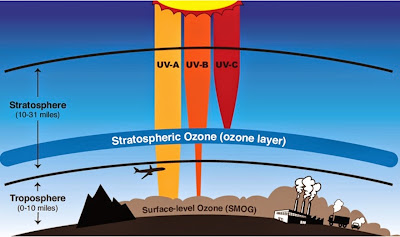Minimum concentration of ozone in the southern hemisphere for each year from 1979-2013 (there is no data from 1995).
Each image is the day of the year with the lowest concentration of ozone. A graph of the lowest ozone amount for each year is shown.
Credit: NASA
Miles above the surface of the Earth, a thin layer of ozone gas acts as a shield that protects us from harmful ultraviolet light.
Image Credit: NASA
What is ozone, and why is some ozone “good" while some is "bad?"
Just as humans need sunblock, the Earth needs protection too. Earth’s sunscreen is called ozone.
The ozone that protects us, and all life on Earth, from the Sun’s harmful UV radiation is high in the atmosphere, in the stratosphere.
But there is also ozone closer to Earth in the troposphere and that is harmful to the health of people, plants and animals.
Decades ago scientists discovered that the Earth’s “good” ozone layer was thinning. It was being depleted by chlorofluorocarbons (CFCs), but the international community came together with an agreement to vastly curtail the use CFCs.
The UN General Assembly proclaimed September 16 the International Day for the Preservation of the Ozone Layer, commemorating the date of the signing of the Montreal Protocol on Substances that Deplete the Ozone Layer.
The theme for this year’s celebration is “Ozone Layer Protection: The Mission Goes On.”
The Montreal Protocol has so far been successful in meeting some of its targets, as a result, the abundance of ozone-depleting substances in the atmosphere is declining and the ozone layer is expected to recover around the middle of this century.







No comments:
Post a Comment